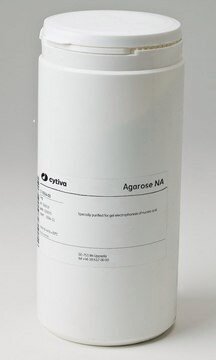Key Documents
A9414
Agarose, low gelling temperature
BioReagent, for molecular biology
Synonim(y):
3,6-Anhydro-α-L-galacto-β-D-galactan, LMP agarose, 2-Hydroxyethyl agarose
About This Item
Polecane produkty
pochodzenie biologiczne
algae (red)
Poziom jakości
klasa czystości
for molecular biology
linia produktu
BioReagent
Postać
powder
EEO
≤0.10
mp
≤65 °C
temp. przejścia
congealing temperature 26-30 °C
siła żelu
≥200 g/cm2 (1% gel)
ślady anionów
sulfate (SO42-): ≤0.10%
przydatność
suitable for electrophoresis
suitable for molecular biology
obecność zanieczyszczeń
DNase, RNase, NICKase, none detected
Opis ogólny
Zastosowanie
- for gel electrophoresis, low melting temperature is ideal for DNA extraction from gel -gel scaffold material for tissue engineering using BMSCs
- to embed tissues in 5% agarose for immunohistology
- for preparation of collagen-agarose co-gels to study collagen-matrix interactions in soft tissues
- single-celled gel electrophoresis (comet assay)
- for in-vivo 3-D imaging of zebrafish larvae immobilized on agarose strips
Cechy i korzyści
- BioReagent suitable for gel electrophoresis
- Band separation range: 200 bp - 25 kB - low gelling temperature is ideal for cell culture and viral plaque assays
- low melting point (LMP) gel is compatible with several DNA recovery methods: phenol/chloroform extractions, recovery columns, electroelution, Beta-Agarase, and freeze/squeeze
- Guaranteed quality tested for use in molecular biology, free of DNase and RNase
Komentarz do analizy
Sulfate content - used as an indicator of purity, since sulfate is the major ionic group present.
Gel strength - the force that must be applied to a gel to cause it to fracture.
Gel point - the temperature at which an aqueous agarose solution forms a gel as it cools. Agarose solutions exhibit hysteresis in the liquid-to-gel transition - that is, their gel point is not the same as their melting temperature.
Electroendosmosis (EEO) - a movement of liquid through the gel. Anionic groups in an agarose gel are affixed to the matrix and cannot move, but dissociable counter cations can migrate toward the cathode in the matrix, giving rise to EEO. Since electrophoretic movement of biopolymers is usually toward the anode, EEO can disrupt separations because of internal convection.
Inne uwagi
Kod klasy składowania
11 - Combustible Solids
Klasa zagrożenia wodnego (WGK)
WGK 3
Temperatura zapłonu (°F)
Not applicable
Temperatura zapłonu (°C)
Not applicable
Środki ochrony indywidualnej
Eyeshields, Gloves, type N95 (US)
Certyfikaty analizy (CoA)
Poszukaj Certyfikaty analizy (CoA), wpisując numer partii/serii produktów. Numery serii i partii można znaleźć na etykiecie produktu po słowach „seria” lub „partia”.
Masz już ten produkt?
Dokumenty związane z niedawno zakupionymi produktami zostały zamieszczone w Bibliotece dokumentów.
Klienci oglądali również te produkty
Nasz zespół naukowców ma doświadczenie we wszystkich obszarach badań, w tym w naukach przyrodniczych, materiałoznawstwie, syntezie chemicznej, chromatografii, analityce i wielu innych dziedzinach.
Skontaktuj się z zespołem ds. pomocy technicznej

